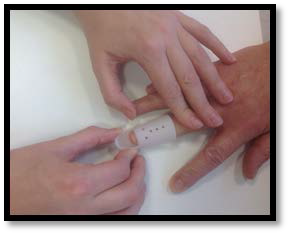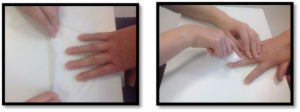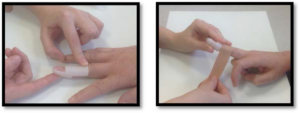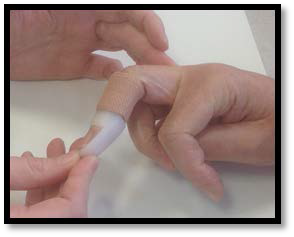This is a bony injury to the tendon in your finger

The extensor tendon, which attaches to the bone at the end of your finger and usually allows you to straighten it, has broken. This injury results in being unable to straighten the tip of the finger.
It normally takes up to 12 weeks to heal and you will need to wear a splint full time for the first 8 weeks to allow the tendon to heal.
Smoking will slow down your healing. We would advise that you stop smoking while your fracture heals. Talk to your GP or go to www.smokefree.nhs.uk for more information.
Pain and Swelling:
Your finger may be swollen and you will have some pain. Take pain medications as prescribed. Taking pain medication and using ice or cold packs will help. More information is in the next section.
You may use the injured hand for light tasks but it is very important to keep the splint clean, dry and well secured with tape/Velcro. It is important to keep your other fingers, thumb and wrist moving to prevent stiffness.
You do not need to wear a sling.
Follow up:
Patients with this condition are not routinely followed up by the Fracture clinic but will be referred to the Hand Therapy Department for further care. If you have not heard from the Hand Therapy Team within one week please contact the Virtual Fracture Clinic.
Contact us:
If you are concerned about your symptoms, are unable to follow this rehabilitation plan, notice pain other than in your finger or have any questions, please contact the Virtual Fracture Clinic.
Caring for your injury: Splinting
You have been provided with a splint. It is important for you to wear this splint at all times in order for the injured tendon to heal. If the fingertip is allowed to bend during this time, it may not heal properly and the ‘droop’ of the finger will become permanent. The splint should therefore be worn constantly, do not remove the splint to shower, when you go to bed, or at any time other than for cleaning purposes as described below.
You will need to remove your splint approximately once in two days in order to clean the skin and change the tape/Velcro holding the splint in place. The splint must be clean and dry at all times, and it is important to regularly check the skin condition. If the skin inside the splint is wet for long, it may become uncomfortable, smelly and possibly infected.
It is very important that you do not bend the tip of your finger whilst the splint is removed; make sure you keep it fully supported on a flat surface such as a table top (placing your finger on your leg is not supportive enough).
This process will be easiest and safest if you can ask someone else to help you and if you prepare everything you will need before removing the splint. You will need a small pair of scissors, some skin wipes or a damp cloth, a dry towel or paper towel and a roll of tape to secure the splint to your finger. The tape should have some elasticity, e.g. Elastoplast (other elastic adhesive bandages are available); these are available from chemists. If you are allergic to this an alternative will be advised.
Splint Care
- Remove the old tape/Velcro from the splint and then carefully slide the splint off of the finger, ensuring the tip of the finger stays straight and supported on the table.

- Clean the skin with wipes or a damp cloth, then dry it fully, being careful to ensure that the fingertip does not bend. Also clean and dry the splint.

- Once the skin and splint are completely dry, slide the splint back on to the finger and secure it with Velcro/or a strip of tape as advised. Make sure the finger is held fully straight whilst the new tape/Velcro is being applied.

- You should be able to bend the middle joint of your finger in your splint. It is important to do this regularly to stop the joint from getting stiff.

Frequently Asked Questions
I’m concerned about my symptoms and/or I am struggling to return to exercise.
Please contact the Virtual Fracture Clinic.
When can I start driving?
You can return to driving when:
- You can move comfortably
- You can control the vehicle safely
Always test your ability to drive in a safe environment first
How can I get a certificate for work?
You can self-certify for the first 7 days following your injury. For any longer periods, please discuss the provision of a fitness to work statement with the Virtual Fracture Clinic Team or your GP.
How do I contact the Virtual Fracture Clinic?
Call 01582 718121. Messages will be checked every morning Monday-Friday.
Email VFC@ldh.nhs.uk
